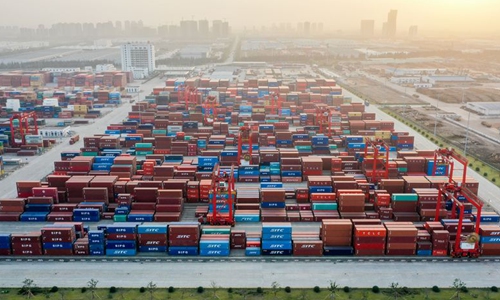HOME >> SOURCE
Trade war sets trend for China’s export diversification
Source:Global Times Published: 2019/12/16 23:27:27

A view of a container port in Taicang, east China's Jiangsu Province, Oct. 30, 2019. (Xinhua/Li Bo)
China will probably buy more US goods next year, but that won't reverse the impact of the trade war, which has seen China pursue export diversification as breakthrough.The diversification trend of China's exports has been notably obvious so far this year. While bilateral trade between China and the US witnessed a remarkable decline, China's trade with the EU and the Association of Southeast Asian Nations (ASEAN) jumped considerably. According to the latest statistics from the General Administration of Customs, in the first 11 months of this year, China's trade with the US fell 11.1 percent year-on-year, with its exports to the US down by 8.4 percent. Meanwhile, China's trade with the EU rose 7.7 percent, with its exports to the EU up 9.5 percent, while its trade with the ASEAN increased 12.7 percent, with its exports up 16.9 percent.
Although the US and China have reached a cease-fire trade deal, the latter still needs to become more flexible in responding to America's China policy by improving its trade structure, which was too dependent on the US for a long time.
China's heavy reliance on the US market for its exports in some areas is nothing new, and for years, the country had been trying to change the situation, but only to see little results. However, due to the pressure of the trade war, Chinese companies have been forced to make adjustment toward diversifying over the past year. And such efforts won't stop once start. For Chinese exporters, how to explore new markets and develop new products based on the market needs will be the main challenges facing them in the year to come.
Of course, there is no denying that it will be a daunting task for the entire Chinese economy to expand and diversify exports. This is also why the Chinese government has begun to formulate policy guidelines to promote trade in line with the diversification trend. Meanwhile, in order to deepen reform and opening-up, China has also pledged to further expand and diversify imports, which, to a certain extent, may also facilitate exports. In fact, imports and exports are complementary to each other in many cases. The imports of high-tech and high-quality products will be conducive to the transformation and upgrade of the domestic economic structure, offering guidance and reference for domestic companies to explore diversified markets.
Overall, the improved foreign trade structure as well as the diversification pursuit will be an important part of China's economic transformation in the years to come. And such adjustment will not just reduce China's reliance on US imports and exports. More importantly, it will bring major impact to the pattern of global trade in the long run.
Posted in: GT VOICE